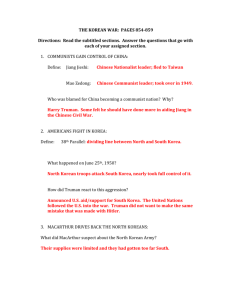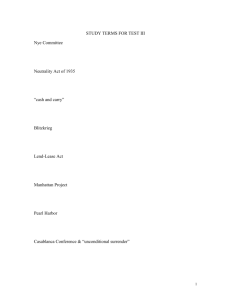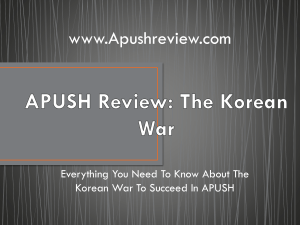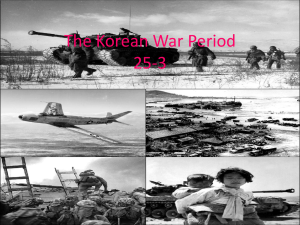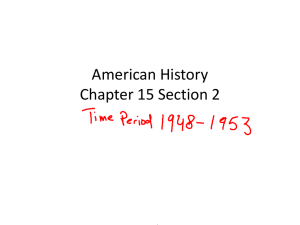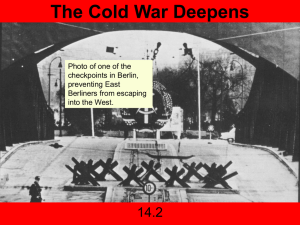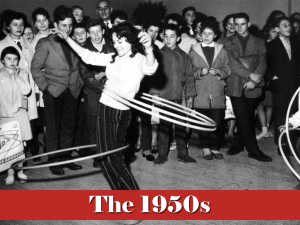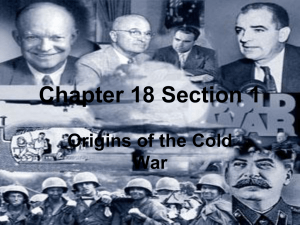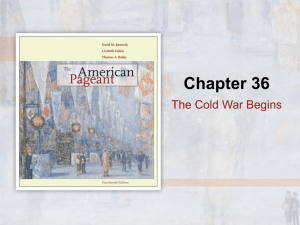Outcome 2.3 Cold War – Proxy Wars
advertisement
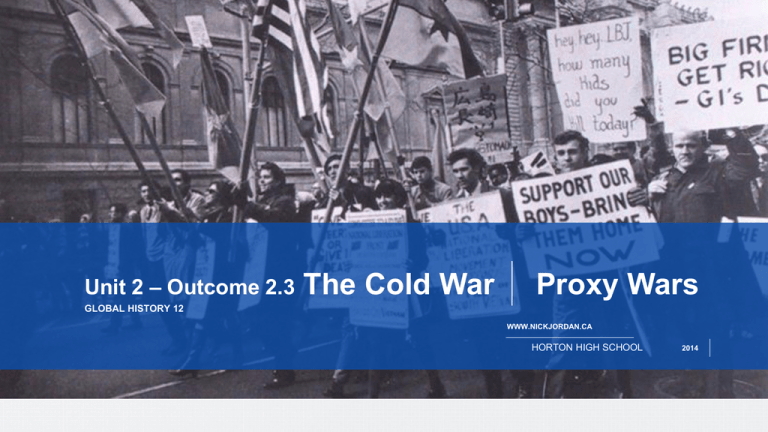
PAGE 1 Unit 2 – Outcome 2.3 The Cold War Proxy Wars GLOBAL HISTORY 12 WWW.NICKJORDAN.CA HORTON HIGH SCHOOL 2014 GLOBAL HISTORY 12 CHINA – QUELLING A REVOLUTION • For two decades, Chinese communists had struggled against the nationalist government of Chiang Kai-Shek • The U.S. supported Chiang and gave the Nationalist Party $3 billion in aid during WWII • However, Mao Zedong’s Communist Party in China was strong, especially among Chinese peasants PAGE 2 The Cold War Heats Up! PAGE 3 Chinese Civil War BATTLE FOR RED CHINA • After Japan left China at the end of the War, Chinese Nationalists and Communists fought a bloody civil war • Despite the U.S. sending $ billions to the Nationalists, the Communists under Mao won the war and ruled China • Chiang and the Nationalists fled China to neighboring Taiwan (Formosa) • Mao established the People’s Republic of China MAO Kai-Shek REPARATIONS • The American public was shocked that China had fallen to the Communists • Many believed containment had failed and communism was expanding • American fear of communism and communist expansion was increasing PAGE 4 YOU OWE US The North Attacks the South June 1950 – July 1953 • On June 25, 1950, North Korean forces swept across the 38th parallel in a surprise attack on South Korea • With only 500 U.S. troops in South Korea, the Soviets figured the Americans would not fight to save South Korea • Instead, America sent troops, planes and ships to South Korea PAGE 5 The Korean War AMERICAN PUSH BACK At first, North Korea seemed unstoppable However, General MacArthur launched a counterattack with tanks, heavy artillery, and troops Many North Koreans surrendered; others retreated across the 38th parallel PAGE 6 MacArthur CHINA JOINS THE WAR • Just as it looked like the Americans were going to score a victory in the North, 300,000 Chinese soldiers joined the war on the side of the North Koreans • The fight between North and South Korea had turned into a war in which the main opponents were Chinese Communists vs. America PAGE 7 Korean War PAGE 8 KOREAN WAR Let’s Attack China! • To halt the bloody stalemate, General MacArthur called for an extension of the war into China • Furthermore, MacArthur called for the U.S. to drop atomic bombs on several Chinese cities • President Truman rejected the General’s requests PAGE 9 Korean War MacArthur vs Truman • MacArthur continued to urge President Truman to attack China and tried to go behind Truman’s back – Truman was furious with his general • On April 1, 1951, Truman made the shocking announcement that he had fired MacArthur • Americans were surprised and many still supported their fallen general PAGE 10 Korean War PAGE 11 The Truman Doctrine Helping to rebuild This doctrine, first used in Greece and Turkey in the late 1940s, vowed to provide aid (money & military supplies) to support “free peoples who are resisting outside pressures” Sir Winston Churchill In a 1946 speech, Churchill said, “An iron curtain has descended across the continent” - the division of Europe 1948 Truman Doctrine Stop Communism Buying Friends Containment Loyalty $$ The American policy of “containment” soon expanded into a policy known as the Truman Doctrine” By 1950, the U.S. had given $400 million in aid to Greece and Turkey PAGE 12 The Marshall Plan ECONOMIC AID TO REBUILD EUROPE • Post-war Europe was devastated economically • In June 1947, Secretary of State George Marshall proposed a U.S. aid package to European nations • Western Europe accepted the help, while Eastern Europe (read Stalin) rejected the aid The Marshall Plan helped Western Europe recover economically ECONOMIC AID TO REBUILD EUROPE • Over the next four years 16 European countries received $13 billion in U.S. aid • By 1952 Western Europe’s economy was flourishing PAGE 13 The Marshall Plan Super Powers struggle over Germany • At the end of the war, Germany was divided among the Allies into four zones for the purpose of occupation • The U.S, France, and Great Britain decided to combine their 3 zones into one zone – West Germany, or the federal Republic of Germany • The U.S.S.R. controlled East Germany, or the German Democratic Republic • Now the superpowers were occupying an area right next to each other – problems were bound to occur PAGE 14 GERMAN BATTLE Battle for Berlin • The Berlin blockade (June ‘48 – May ‘49) was one of the first major international crises of the Cold War. • During the multinational occupation of post–World War II Germany, the Soviet Union blocked the Western Allies' railway, road, and canal access to the sectors of Berlin under allied control. • Their aim was to force the western powers to allow the Soviet zone to start supplying Berlin with food, fuel, and aid, thereby giving the Soviets practical control over the entire city. PAGE 15 BERLIN BLOCKADE 1948 Soviet Plan Foiled • Not wanting to invade and start a war with the Soviets, America and Britain started the Berlin airlift to fly supplies into West Berlin • For 327 days, planes took off and landed every few minutes, around the clock PAGE 16 BERLIN AIRLIFT Soviet Plan Foiled • In 277,000 flights, they brought in 2.3 million tons of food, fuel and medicine to the West Berliners • Realizing they were beaten and suffering a public relations nightmare, the Soviets lifted their blockade in May, 1949 PAGE 17 BERLIN AIRLIFT The West Creates a Military Alliance • The Berlin blockade increased Western Europe’s fear of Soviet aggression • As a result, ten West European nations joined the U.S and Canada on April 4, 1949 to form a defensive alliance known as the North Atlantic Treaty Organization PAGE 18 NATA FORMED
